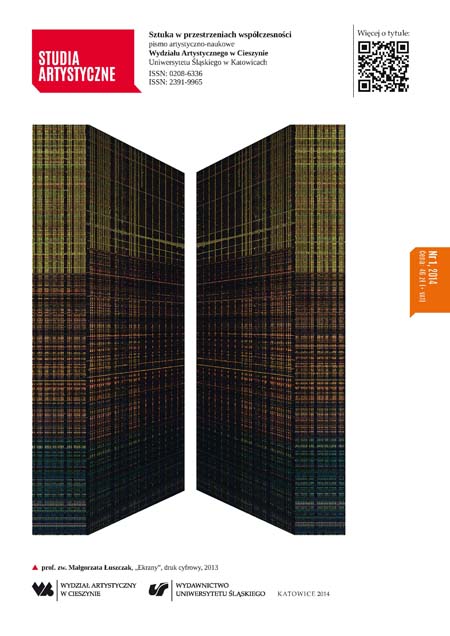Do czego potrzebna jest dziś sztuka?
What do we need art for today?
Author(s): Ireneusz BotorSubject(s): Fine Arts / Performing Arts
Published by: Wydawnictwo Uniwersytetu Śląskiego
Keywords: change; cultural identity; mythologization
Summary/Abstract: There exists a need to find a solution to the stability of a cultural identity and its record in the face of a dynamic nature of reality changes. An art building mythologies can play an important part here, but it must fulfill certain conditions. The importance of art results among others from the fact that it uses signs and is able to revalue or verify this very system. It can also include certain realities into a meaningful system, and, thereby, form new points of view and perspectives, narrations and mythologies. The considerations presented in the article referred to the 2012 Berlin Art Biennale. Today’s world, and globalization processes taking place therein, cause the pressure of the problem of subjectivity. A reflective nature of art can be an undesired burden when creating a consumer society. What is vital for artists is a deepened awareness of time in which one lives and mechanisms he/she is governed by. The very issue is complex because our reality is not homogeneous. Art means different things in different environments. An art recording today’s world, showing unknown spaces or even those marginal and excluded one is necessary for building a culture continuity. What is necessary is also the one that contributes to the cultural continuation and touches upon developmental issues here, as well as creates and records their narrations or even mythologies. It is vital that we refer to common values here. The 2012 Berlin Art Biennale showed very strong tendencies in order to make art a forum for changes of our current reality. What was proposed is a model in which an art should not fabricate a work of art, but make open situations with unknown conclusions possible. It is a misleading situation because it lacks fixed elements guaranteed by an artistic object irrespective of its surrounding. These experiences are referred to the postindustrial area suffering from a deep sociological and cultural transformation. Dynamism and lack of stability characterizing it rather imply the need to search for stable points rather than call for transformations. Transferring experiences of Biennale in an uncritical way here would be nonsensical. If an art is to be treated as a reason for a common good, it should derive from the area or place where it is created. Native values have been appreciated in Poland and references to national myths were made. A current situation gives the floor to the myths forgotten a long time ago, such as a myth of the Galicia or the area of the former Austrian-Hungarian monarchy, as well as a cultural myth of Central Europe. Building mythology can be a cure for deconstruction. The answer to a total change of identity can be its protection by means of deposing information building mythology in a materialized artistic object. The myth constitutes a primary form of explaining things and the world at the level of the feeling. The idea of building mythology is based on several assumptions. The first one is the need of stability...
Journal: Studia Artystyczne
- Issue Year: 2014
- Issue No: 1
- Page Range: 13-19
- Page Count: 7
- Language: Polish

